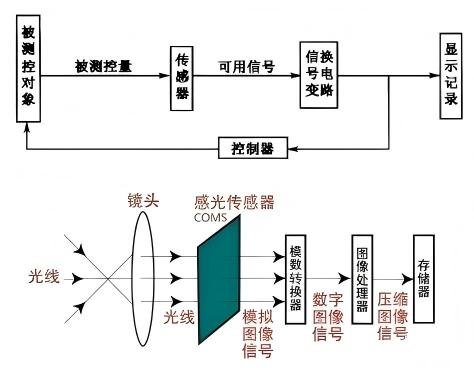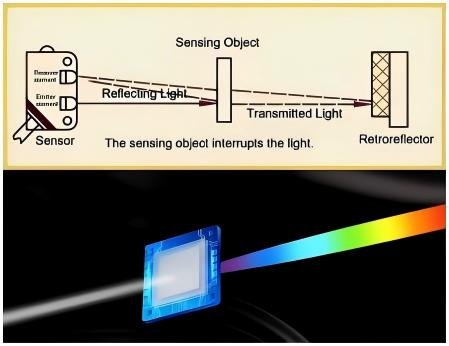Notícias do sector
What Is An Optical Sensor? Classification And Application of Optical Sensors
1.What is an optical sensor?
Optical sensors are an important modern sensing technology. They are devices that use optical principles to detect, measure, or sense physical quantities (such as light intensity and wavelength) or environmental parameters (such as temperature and pressure). Their primary function is to detect changes in optical signals and convert them into electrical signals or other processable forms, enabling the extraction and analysis of target information.
(1)The working principle of optical sensors
Optical sensors acquire information by receiving and converting light signals. Their basic operating principle is to exploit the physical or chemical changes produced when light interacts with matter. These changes can include light intensity, wavelength, frequency, polarization state, and other factors.
A sensor system typically consists of a light source, a detector, and a signal processing unit. The light source emits light signals, which the detector receives and analyzes. The signal processing unit then converts the light signals into readable electrical signals.

What is an optical sensor
(2)Components of an optical sensor
An optical sensor typically consists of the following components:
①Light source: Provides the optical signal required for detection. Common light sources include lasers, LEDs, incandescent lamps, etc.
②Optical components: Used to modulate, transmit or focus optical signals, such as lenses, prisms, optical fibers, filters, etc.
③Detector: Converts light signals into electrical signals. Commonly used detectors include photodiodes, photomultiplier tubes, CCD/CMOS image sensors, etc.
④Signal processing unit: Processes and analyzes the electrical signals output by the detector to extract target information.

Components of an optical sensor
2.Classification of optical sensors
Optical sensors can be divided into different types according to different working principles and application scenarios. The following are common types of optical sensors:
①Photoelectric sensor: uses the photoelectric effect to convert light signals into electrical signals. For example, photodiode sensors generate current by absorbing photons. They are primarily used to detect changes in light intensity and are commonly used in optical communications and light detection.
②Fiber optic sensor: Using optical fiber as a sensing element, it can detect changes in the propagation characteristics of light, such as refractive index and phase. Fiber optic sensors are highly sensitive and anti-interference, making them suitable for measurements over long distances or in harsh environments.
③Interferometric sensors: These detect physical quantities such as temperature, pressure, and displacement by measuring changes in the interference pattern of light waves. Common interferometric techniques include Michelson interferometry and Fabry-Perot interferometry.
④Spectral sensor: Based on CMOS pixel array, it is used to analyze spectral characteristics such as absorption spectrum and emission spectrum, and is often used in chemical composition spectral analysis and environmental monitoring.

Classification of optical sensors
3.Applications of optical sensors
Optical sensors are widely used in many fields due to their non-contact, high precision and fast response characteristics:
(1)Environmental monitoring
Optical sensors are used for environmental monitoring, primarily gas detection and water quality testing. For example, they can be used to detect pollutant concentrations in the air, salinity in water, and chemical concentrations.
(2)Biomedical sciences
Optical sensors are widely used in the biomedical field to measure biomedical parameters, such as detecting glucose concentration in the blood and measuring blood oxygen saturation.
(3)Industrial automation
In industrial production, optical sensors are mainly used in machine vision, automated control, and quality inspection, etc. They are used to detect product quality, such as illumination, cosine characteristics, spectral sensitivity, etc.

Applications of optical sensors
(4)Automóvel electronics
Optical sensors are mainly used in the automotive electronics industry for obstacle detection and navigation in autonomous driving systems.
(5)Military and defense
In the military and defense sectors, optical sensors are primarily used to detect biological and chemical threats, monitor soldier health, and improve combat readiness.
For example, technologies such as luminescence, fluorescence, evanescent wave and surface plasmon resonance (SPR) sensors are used to identify pathogens such as Bacillus anthracis and Clostridium botulinum neurotoxin; infrared sensors are used for night vision and thermal imaging; and lidar is used for target detection and tracking.
(6)Communications and information technology
In the field of fiber optic communications, fiber optic sensors can be used to monitor the performance of fiber optic networks, and optical encoders can be used for high-precision position measurement.
In addition, optical sensors are also used in smart homes, such as for temperature, distance, speed measurement and 3D imaging.
This shows that optical sensors have a wide range of applications and occupy a vital position in modern technology. As the optical industry develops and demands in various fields increase, optical sensor technology will continue to develop and remain at the core of technological progress.

